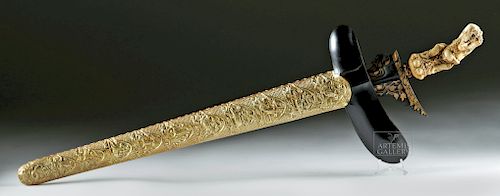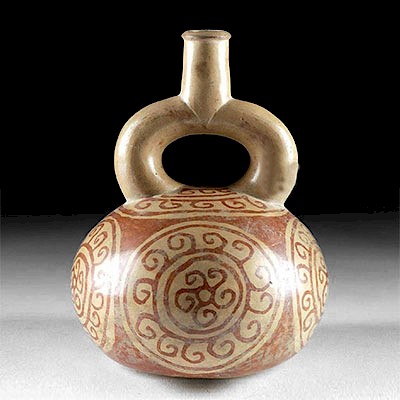19th C. Indonesian Iron, Silver, & Ivory Kris
Lot 128
About Seller
Artemis Fine Arts
686 S Taylor Ave, Ste 106
Louisville, CO 80027
United States
Selling antiquities, ancient and ethnographic art online since 1993, Artemis Gallery specializes in Classical Antiquities (Egyptian, Greek, Roman, Near Eastern), Asian, Pre-Columbian, African / Tribal / Oceanographic art. Our extensive inventory includes pottery, stone, metal, wood, glass and textil...Read more
Categories
Estimate:
$800 - $1,200
Absentee vs Live bid
Two ways to bid:
- Leave a max absentee bid and the platform will bid on your behalf up to your maximum bid during the live auction.
- Bid live during the auction and your bids will be submitted real-time to the auctioneer.
Bid Increments
| Price | Bid Increment |
|---|---|
| $0 | $25 |
| $300 | $50 |
| $1,000 | $100 |
| $2,000 | $250 |
| $5,000 | $500 |
| $10,000 | $1,000 |
| $20,000 | $2,500 |
| $50,000 | $5,000 |
| $100,000 | $10,000 |
| $200,000 | $20,000 |
About Auction
By Artemis Fine Arts
Jan 24, 2019
Set Reminder
2019-01-24 10:00:00
2019-01-24 10:00:00
America/New_York
Bidsquare
Bidsquare : Pre-Columbian / Ethnographic Art
https://www.bidsquare.com/auctions/artemis-gallery/pre-columbian-ethnographic-art-3814
Featuring ancient and ethnographic art from around the world, including Pre-Columbian, Native American, African / Tribal, Ethnographic, Spanish Colonial, Fossils, Fine Art, much more. Artemis Fine Arts info@artemisgallery.com
Featuring ancient and ethnographic art from around the world, including Pre-Columbian, Native American, African / Tribal, Ethnographic, Spanish Colonial, Fossils, Fine Art, much more. Artemis Fine Arts info@artemisgallery.com
- Lot Description
Southeast Asia, Indonesia, (handle) ca. late 19th century CE; blade & scabbard date to ca. first half of the 20th century CE. A beautiful kris sword used in ceremonial court-related events. The handle is carved from elephant ivory and takes the form of a dancing god with wide eyes and elaborate curled hair. A gilded silver ring is inlaid with four garnets and four blue glass cabochons and separates the handle from the wide, dark wood blade guard. The iron blade has a slight serpentine profile with projecting lateral elements, a bifurcated groove underneath the guard, and sharpened edges which taper to a point, and inlaid gilding in a floral motif. The wooden sheath is covered with gilded silver, featuring repousse animals in registers down its length. Size: 8" W x 24" H (20.3 cm x 61 cm)
The kris is both a weapon and a spiritual object. The oldest known are from the 10th century CE; they are thought to have originated on the island of Java. The bladesmith, called an empu, formed the blade from layers of different iron ores and meteorite nickel. In high quality ones, the metal is folded dozens or even hundreds of times. Kris were worn every day and in special ceremonies; both men and women wear them. They were passed down through families. They were used for display, as talismans with magical powers, and weapons, and as heirlooms, as accessories for ceremonial dress, and indicators of social status. Kris blades are narrow, with wide, symmetrical bases. The aesthetic value has three elements: dhapur, the shape and design of the blade, with 40 variants; pamor, the pattern of metal alloy decoration on the blade, with 120 variants; and tangguh, the age and origin of kris. In 2005, the kris became a UNESCO Masterpiece of the Oral and Intangible Heritage of Humanity.
Please note that ivory from any species cannot be shipped to the US States of California, Hawai'i, Nevada, New Hampshire, New Jersey, New York, Oregon, and Washington State. As of 2019, they will not be able to be shipped to Illinois.
The ivory on this item pre-dates 1900 and was acquired long before the 1970 ban on ivory trade.
Provenance: private Rochester, Michigan, USA collection
All items legal to buy/sell under U.S. Statute covering cultural patrimony Code 2600, CHAPTER 14, and are guaranteed to be as described or your money back.
A Certificate of Authenticity will accompany all winning bids.
We ship worldwide and handle all shipping in-house for your convenience.
#138001One stone cabochon missing on silver ring. Minor nicks to blade edges, handle, and sheath, with some yellowing to handle, and fading to some areas of sheath pigmentation, otherwise intact and very good. Light earthen deposits throughout.Condition
- Shipping Info
-
All shipping is handled in-house for your convenience. Your invoice from Artemis Gallery will include shipping calculation instructions. If in doubt, please inquire BEFORE bidding for estimated shipping costs for individual items.
-
- Buyer's Premium



 EUR
EUR CAD
CAD AUD
AUD GBP
GBP MXN
MXN HKD
HKD CNY
CNY MYR
MYR SEK
SEK SGD
SGD CHF
CHF THB
THB















